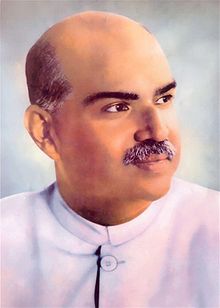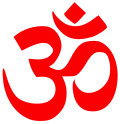- Syama Prasad Mookerjee
-
Shyama Prasad Mookerjee
শ্যামপ্রসাদ মুখোপাধ্যায়
Personal details Born 6 July 1901
Kolkata, Bengal, British IndiaDied 23 June 1953 (aged 51) Nationality Indian Political party Hindu Mahasabha, Bharatiya Jana Sangh Religion Hinduism Dr. Shyama Prasad Mookerjee (or Syama Prasad Mukherjee, Bengali: শ্যামাপ্রসাদ মুখোপাধ্যায়) (July 6, 1901 – June 23, 1953) was a minister in Jawaharlal Nehru's Cabinet as a Minister for Industry and Supply.
Mookerjee founded the Bharatiya Jana Sangh in 1951, after the differences with Pandit Nehru.
Contents
Early life
Mookerjee was born on July 6, 1901 in Kolkata. His father was Sir Ashutosh Mukherjee, a well-respected advocate in Bengal, who became the Vice-Chancellor of the University of Calcutta, and his mother was Lady Jogmaya Devi Mookerjee.
Mookerjee obtained his degrees from the University of Calcutta. He graduated in English securing the first position in first class in 1921 and also did MA in 1923 and BL in 1924. He became a fellow of the Senate in 1923. He enrolled as an advocate in Calcutta High Court in 1924 after his father had died shortly after losing to Syed Hasan Imam at Patna high court. Subsequently he left for England in 1926 to study at Lincoln's Inn and became a barrister in 1927. At the age of 33, he became the youngest Vice-Chancellor of the University of Calcutta (1934), and held the office till 1938.
Political career
He was elected as member of the Legislative Council of Bengal, as an Indian National Congress candidate representing Calcutta University but resigned next year when Congress decided to boycott the legislature. Subsequently, he contested the election as an independent candidate and got elected. He was the Finance minister of Bengal Province during 1941-42.
He emerged as a spokesman for Hindus and shortly joined Hindu Mahasabha and in 1944, he became the President. Dr. Mookerjee was political leader who felt the need to counteract the communalist and separatist Muslim League of Muhammad Ali Jinnah, who were demanding either exaggerated Muslim rights or a Muslim state of Pakistan.
Dr.Mookerjee adopted causes to protect Hindus against what he believed to be the communal propaganda and the divisive agenda of the Muslim League. Mookerjee and his future followers would always cite inherent Hindu practices of tolerance and communal respect as the reason for a healthy, prosperous and safe Muslim population in the country in the first place.
Dr.Mookerjee was initially a strong opponent of the Partition of India, but following the communal riots of 1946-47, Mookerjee strongly disfavored Hindus continuing to live in a Muslim-dominated state and under a government controlled by the Muslim League.
On 11 February 1941 S P Mookerjee told a Hindu rally that if Muslims wanted to live in Pakistan they should "pack their bag and baggage and leave India... (to) wherever they like".[1]
Dr.Mookerjee supported the partition of Bengal in 1946 to prevent the inclusion of its Hindu-majority areas in a Muslim-dominated East Pakistan;[2] he also opposed a failed bid for a united but independent Bengal made in 1947 by Sarat Bose, the brother of Subhas Chandra Bose and Huseyn Shaheed Suhrawardy, a Bengali Muslim politician.
He wanted the Hindu Mahasabha not to be restricted to Hindus alone or work as apolitical body for the service of masses. Following the assassination of Mahatma Gandhi by a Hindu fanatic, the Mahasabha was blamed chiefly for the heinous act and became deeply unpopular. Mookerjee himself condemned the murder.
Post-independence
Prime Minister Jawaharlal Nehru inducted him in the Interim Central Government as a Minister for Industry and Supply. Mookerjee was widely respected by many Indians and also by members of the Indian National Congress, and Sardar Vallabhbhai Patel, one of its chief leaders.
But on issue of the 1950 Delhi Pact with Pakistani Prime Minister Liaqat Ali Khan, Dr.Mookerjee resigned from the Cabinet on April 6, 1950. Mookerjee was firmly against Nehru's invitation to the Pakistani PM, and their joint pact to establish minority commissions and guarantee minority rights in both countries. He wanted to hold Pakistan directly responsible for the terrible influx of millions of Hindu refugees from East Pakistan, who had left the state fearing religious suppression and violence aided by the state. Mookerjee considered Nehru's actions as appeasement, and was hailed as a hero by the people of West Bengal.[citation needed]
Dr. Shyama Prasad Mookerjee founded the Bharatiya Jana Sangh (BJS) on October 21, 1951, following his parting ways with Nehru.[3] The BJS was ideologically close to the Rashtriya Swayamsevak Sangh (RSS) and widely considered the political arm of Hindu Nationalism. It was opposed to appeasement of India's Muslims, and favoured free-market economics as opposed to the socialist policies pursued by Nehru. The BJS also favored a uniform civil code governing personal law matters for both Hindus and Muslims, wanted to ban cow slaughter and end the special status given to the Muslim-majority state of Jammu and Kashmir. The BJS founded the Hindutva agenda which became the wider political expression of India's Hindu majority. He was also influential with the more conservative members within the Congress.
In the 1952 general elections to the Parliament of India, Dr. Mookerjee and the BJS won three seats.
Dr.Shyama Prasad Mookerjee opposed the Indian National Congress's decision to grant Kashmir a special status with its own flag and Prime Minister. According to Congress's decision, no one, including the President of India could enter into Kashmir without the permission of Kashmir's Prime Minister. In opposition to this decision, he once said "Ek desh mein do Vidhan, do Pradhan and Do Nishan nahi challenge" (A single country can't have two constitutions, two prime ministers, and two National Emblems).
Dr. Mookerjee went to visit Kashmir in 1953, and observed a hunger strike to protest the law that prohibited Indian citizens from settling in a state within their own country and mandated that they carry ID cards. He was arrested on May 11 while crossing border into Kashmir. Although the ID card rule was revoked owing to his efforts, he died as detenu on June 23, 1953 under mysterious circumstances.
Death
Dr. Shyama Prasad was arrested on entering Kashmir on May 11, 1953. Thereafter, he was jailed in a dilapidated house.[4] Dr. Shyama Prasad had suffered from dry pleurisy and coronary troubles, and was taken to hospital one and a half months after his arrest due to complications arising from the same.[citation needed] He was administered penicillin despite having informed the doctor-in-charge of his allergy to penicillin, and he died on June 23, 1953.
It was strongly rumored that he was poisoned in custody and Sheikh Abdullah and Nehru had conspired to do the same.No post-mortem was ordered in total disregard of the rule. Maulana Azad, who was acting Prime Minister ( in absence of Nehru, who was away in London ), did not allow body to be brought to Delhi and dead body was directly flown to Calcutta.[4]
His death in custody raised wide suspicion across the country and demands for independent enquiry were raised, including earnest requests from his mother, Jogmaya Devi, to Jawaharlal Nehru. Nehru declared that he had enquired from a number of persons who were privy to the facts and, according to him, there was no mystery behind Dr. Mookerjee's death. Jogmaya Devi did not accept Nehru's reply and requested the setting up of an impartial enquiry. Nehru however ignored the letter and no enquiry commission was set up. Mookerjee's death therefore remains a matter of some controversy.[5] Atal Behari Vajpayee claimed in 2004 that the death of Mookherjee was a "Nehru conspiracy".[6]
However, it was Mookherjee's martyrdom, which later compelled, Nehru to remove Permit system, post of Sadar-e-Riayasat and of Prime Minsiter of Jammu & Kashmir.[7]
Legacy
Along with Vinayak Damodar Savarkar, Dr. Mookerjee is considered the godfather of Hindu nationalism in India, especially the Hindutva movement.Though Dr.Mookerjee was not associated with Rashtriya Swayamsevak Sangh, he is widely revered by members and supporters of the Rashtriya Swayamsevak Sangh and the Vishwa Hindu Parishad.
On April 22, 2010, Municipal Corporation of Delhi's newly constructed Rs. 650-crore building (the tallest building in Delhi) was named "Doctor Shyama Prasad Mukherjee Civic Centre".[8] The Civic Centre was inaugurated by Home Minister P Chidambaram. The building, which will cater to an estimated 20,000 visitors per day, will also house different wings and offices of the Municipal Corporation of Delhi (MCD). Delhi also has a major road named after Dr. S.P. Mukherjee.
On August 27, 1998, the Ahmedabad Municipal Corporation named a bridge after Mookerjee.[9]
A BEST bus junction near the Chhatrapati Shivaji Museum (formerly the Prince of Wales Museum) and Regal Cinema in Mumbai is named as "Shyamaprasad Mukherjee Chowk" in his honour.
In 2001, the main research funding institute of the Government of India, CSIR instituted a new fellowship named after him. The Shyama Prasad Mukhejee Fellowship is the most prestigious fellowship given in India for doing PhD. Only the top 20% students who clear the Junior Research Fellowship (JRF CSIR/UGC) are eligible to sit for this examination.
References
- ^ Legislative Council Proceedings [BLCP], 1941, Vol. LIX, No. 6, p 216
- ^ "Dr. Shyama Prasad Mookerjee". Bengal Voice. http://shyamaprasad.org/about.htm. Retrieved January 28, 2011.
- ^ http://www.britannica.com/EBchecked/topic/919608/Bharatiya-Jana-Sangh
- ^ a b The first prime minister of India By Y. G. Bhave. pp. 49. http://books.google.co.in/books?id=Ye3VUMLhaz8C&pg=PA49&dq=shyama+prasad+mukherjee+arrested+in+kashmir+by+nehru&hl=en&ei=lTlwTov0BsjorQeJzfXnBg&sa=X&oi=book_result&ct=result&resnum=5&ved=0CD4Q6AEwBA#v=onepage&q=arrested%20kashmir&f=false.
- ^ "http://www.rediff.com/news/2009/mar/27guest-column-tarun-vijay-on-dynasty-and-the-varun-effect.htm"
- ^ Nehru conspiracy led to Shyama Prasad's death: Atal Times of India - July 4, 2004
- ^ Mookerjee's martyrdom compelled the Nehru government to remove the permit system and the two heads of state.
- ^ http://in.news.yahoo.com/20/20100613/1416/tnl-new-i-t-office-to-give-relief-to-tax_1.html
- ^ http://www.tribuneindia.com/1998/98aug28/nation.htm
External links
See also
1. Legislative Council Proceedings [BLCP], 1941, Vol. LIX, No. 6, p 216
2. Suranjan Das Communal Riots in Bengal 1905 - 1947; Oxford University Press, 1991
First Union Cabinet of India Nehru (Prime Minister • External Affairs) · Patel (Deputy Prime Minister • Home Affairs) · Baldev Singh (Defence) · Chetty (Finance) · Maulana Azad (Education) · Jagjivan Ram (Labour) · Ambedkar (Law) · Gadgil (Public Works) • (Power) · R. A. Kidwai (Communications) · S. P. Mookerjee (Industry) · Amrit Kaur (Health) · Mathai (Railways)
Sangh Parivar
Organisations Rashtriya Swayamsevak Sangh · Rashtra Sevika Samiti · Bharatiya Janata Party · Vishwa Hindu Parishad · Bajrang Dal · Muslim Rashtriya Manch · Rashtriya Sikh Sangat · Akhil Bharatiya Vidyarthi Parishad · Bharatiya Mazdoor Sangh · Hindu Munnani · Hindu Swayamsevak Sangh · Swadeshi Jagaran Manch · Durga Vahini · Hindu Students Council · Seva Bharathi · Bharatiya Kisan Sangh · Balagokulam · Vidya Bharati · Vanavasi Kalyan Ashram · Hindu Vivek Kendra · Ram Janmabhoomi Nyas
Major figures K.B. Hedgewar · Madhav Sadashiv Golwalkar · Shyama Prasad Mookerjee · Deendayal Upadhyaya · Madhukar Dattatraya Deoras · Atal Bihari Vajpayee · Lal Krishna Advani · Rajju Bhaiya · Ashok Singhal · K.S. Sudarshan · Praveen Togadia · Mohan Bhagwat · Narendra ModiPhilosophy Hindu nationalism (Hindu Rashtra) · Hindutva · Integral humanism · Ram Janmabhoomi · Undivided India (Akhand Bharat) · Uniform civil codeCategories:- First Indian Cabinet
- 1901 births
- 1953 deaths
- Presidency University, Kolkata alumni
- Bengali politicians
- Hindu martyrs
- Hindu revivalists
- Indian academics
- Indian barristers
- Indian politicians
- People from Kolkata
- University of Calcutta alumni
- Unsolved deaths or murders
- Vice Chancellors of the University of Calcutta
- 1st Lok Sabha members
- Bharatiya Janata Party politicians
- Indian independence activists
- Relief workers in Noakhali
Wikimedia Foundation. 2010.

